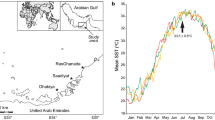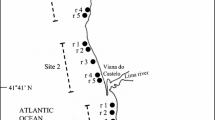Synopsis
Development of the fish community on a submerged 16 m barge and variation in fish abundance on nearby transects were surveyed twice monthly for twenty months. A steady increase in abundance was observed for certain fishes on the barge, whereas a few species exhibited distinct seasonal variation on both the barge and transects. Most of the seasonal species settled between March and May.
Some seasonal species appeared to be site selective in their settlement and consequently settled juveniles were clumped in their distribution. An abundance of preferred topographical features may be why settlement was relatively high at the study site and indirectly why predators became significantly (r3 = 7.67***, N = 37) more abundant at the study area during the months of maximum prey settlement. Concurrent settlement of several species during the same few months may be important because juveniles become an abundant food source to predators during those few months only. Periodic swamping of predators by abundant juvenile prey may improve the chances for individuals of rarer prey species to be overlooked and therefore be succesfully recruited.
Similar content being viewed by others
References cited
Chave, E.H. 1978. General ecology of six species of Hawaiian cardinal fishes. Pacif. Sci. 32: 245–270.
Dale, G. 1978. Money-in-the-bank: a model for coral reef fish coexistence. Env. Biol. Fish. 3: 103–108.
Gladfelter, W.B., J.C. Ogden & E.H. Gladfelter. 1980. Similarity and diversity amoung coral reef fish communities; a comparison between Tropical Western Atlantic (Virgin Islands) and Tropical Central Pacific (Marshall Islands) patch reefs. Ecology 61: 1156–1168.
Hellman, G.S. 1978. Patterns of community structure in fishes: summary and overview. Env. Biol. Fish. 3: 130–149.
Hiatt, R.W. & D.W. Strasburg. 1960. Ecological relationships of the fauna on coral reefs of the Marshall Islands. Ecol. Monog. 30: 65–127.
Hobson, E.S. 1972. Activity of Hawaiian reef fishes during evening and morning transitions between daylight and darkness. U.S. Fish. Bull. 70: 715–740.
Hobson, E.S. 1974. Feeding relationships of teleostean fishes on coral reefs in Kona, Hawaii. U.S. Fish. Bull. 72: 915–1031.
Johannes, R.E. 1978. Reproductive strategies of coastal marine fishes in the tropics. Env. Biol. Fish. 3: 65–84.
Munro, J.L., V.C. Gaut, R. Thompson & P.H. Reeson. 1973. The spawning seasons of Caribbean reef fishes. J. Fish Biol. 5: 69–84.
Paine, R.T. 1966. Food web complexity and species diversity. Amer. Natur. 100: 65–75.
Peterson, R.D. 1972. Effects of light intensity on the morphology and productivity of Caulerpa racemosa. Micronesica 8: 63–86.
Qasim, S.Z. 1955. Time and duration of spawning season of teleosts in relation to their distribution. J. Cons. Internat. Explor. Mer. 21: 144–155.
Root, R.B. 1967. The niche exploitation pattern of the blue-gray gnatcatcher. Ecol. Monog. 37: 317–350.
Russell, B.C., G.R.V. Anderson & F.H. Talbot. 1977. Seasonality and recruitment of coral reef fishes. Aust. J. Mar. Freshw. Res. 28: 521–528.
Russell, B.C., F.H. Talbot & S. Domm. 1974. Patterns of colonization of artificial reefs by coral reef fishes. Proc. 2nd Intern. Coral Reef Symp. 1: 207–215.
Sale, P.F. 1974. Mechanisms of coexistence in a guild of territorial fishes at Heron Island. Proc. 2nd. Intern. Coral Symp. 1: 193–206.
Sale, P.F. 1977. Maintenance of high diversity in coral reef fish communities. Amer. Natur. 111: 337–359.
Sale, P.F. 1980. The ecology of fishes on coral reefs. Oceanogr. Mar. Biol. Ann. Rev. 18: 367–421.
Sale, P.F. & R. Dybdahl. 1975. Determinants of community structure for coral reef fishes in an experimental habitat. Ecology 56: 1342–1355.
Smith, C.L. & J.C. Tyler. 1972. Space resource sharing in a coral reef fish community. pp. 125–170. In: B.B. Collette & S.A. Earle (ed.)Results of Tektite Program: Ecology of Coral Reef Fishes, Los Angeles Co. Mus. Sci. Bull. 14.
Sokal, R.R. & F.J. Rohlf. 1969. Biometry. W.H. Freeman and Co. San Francisco. 776 pp.
Talbot, F.Y., B.C. Russel & G.R.V. Anderson. 1978. Coral reef fish communities: unstable, high-diversity systems? Ecol. Monog. 48: 425–440.
Tsuda, R.T. 1972. Morphological, zonational, and seasonal studies of two species of Sargassum on the reefs of Guam. pp. 40–44. In: Proc. 7th Intern. Seaweed Symp., Sapporo, Japan.
Tsuda, R.T. 1974. Seasonal aspects of the Guam Phaeophyta (brown algae). Proc. 2nd. Intern. Coral Reef Symp. 1: 43–47.
Watson, W. & J.J. Leis. 1974. Ichthyoplankton in Kaneohe Bay, Hawaii. A one-year study of fish eggs and larvae. Univ. Hawaii Sea Grant Tech. Rept. 75-01: 1–178.
Author information
Authors and Affiliations
Rights and permissions
About this article
Cite this article
Logan Kock, R.K. Patterns of abundance variation in reef fishes near an artificial reef at Guam. Environ Biol Fish 7, 121–136 (1982). https://doi.org/10.1007/BF00001782
Received:
Accepted:
Issue Date:
DOI: https://doi.org/10.1007/BF00001782




